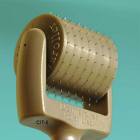Skin rejuvenation is the most frequently requested cosmetic facial procedure, largely by women of ages 35 and above. As the skin starts to look dull and develop those first few wrinkles, doing something to help the skin look better becomes a consideration. The term, skin rejuvenation, encompasses a wide variety of office-based procedures that all aim to make the skin look fresher and reduce wrinkles.
Most commonly, the most effective skin rejuvenation methods include those that exfoliate (remove) the outer layers and allow it to heal with a new outer layer. These methods include traditional chemical peels and different forms of laser resurfacing. All of these procedures can be done in a wide variety of depths, which are individually chosen based on the patient’s tolerance for recovery and the speed at which they want to see improvement.

PCI is best compared to fractional laser resurfacing is that it creates tiny holes or cuts in the skin. Fractional laser procedures makes these cuts with the heat of the laser which leaves behind a wider zone of dead tissue (estimated to be 3 to 8 times wider than the hole) which must also heal. The ‘cauterized’ hole edges theoretically are sealed from releasing cell factors that are helpful in the regenerative process. In essence, some scar is left behind from the process.. PCI, conversely, simply clefts the skin without any heat, which more readily allows valuable cell factors to be released and work on the exposed collagen, resulting in regeneration with less scar healing.
The debate between a high-tech approach (fractional laser) and a low-tech approach (PCI) for skin rejuvenation is ongoing and may become more hotly (no pun intended!) contested in the future. Until a direct comparison in patients is done, this debate will be based on conjecture, extrapolated science, and economics until then. Those issues aside, I find PCI theoretically appealing and with some real clinical benefits. And when I talk about clinical benefits, I am not talking about which is better in terms of skin rejuvenation.
PCI offers less recovery than any laser method and that, for some patients, is a real plus. Many patients would embark on more aggressive skin rejuvenation programs if they didn’t have persistent redness and peeling…not to mention the discomfort of the procedure. (and all laser procedures involve some discomfort, no matter how it is managed, due to the heat) Furthermore, because PCI does not strip off the outer layer of the skin, it offers an advantage of safety and virtual elimination of complications. You can’t have a burn injury if you aren’t doing any burning. This indicates that PCI can be used anywhere on the body unlike laser methods. Also, with no outer layer of skin removed, even partially, this exposes the patient to no risk for skin sensitivity after and has no potential for any pigment changes. (it can be used on all skin types)
Several non-burning questions remain, however, on the effectiveness of PCI? How many treatments are needed to see improvement? What is the best depth of needles and the spacing of them on the wheel? What topical products should ideally be used afterward? The science of PCI remains a fertile area for investigation and much of this information is not yet known. The role of PCI in skin rejuvenation has not been defined, unlike laser technology. This is largely a function of economics. The large number of lasers that are marketed and exist in clinical practices provides a disincentive for the PCI bandwagon.
Despite these drawbacks, I remain both intrigued and encouraged about PCI in my Indianapolis plastic surgery and spa practice. PCI and laser treatments are not mutually exclusive. Light laser micropeeling (less than 50 microns) combined with PCI may capture the best of both worlds.
Dr. Barry Eppley
Indianapolis, Indiana


